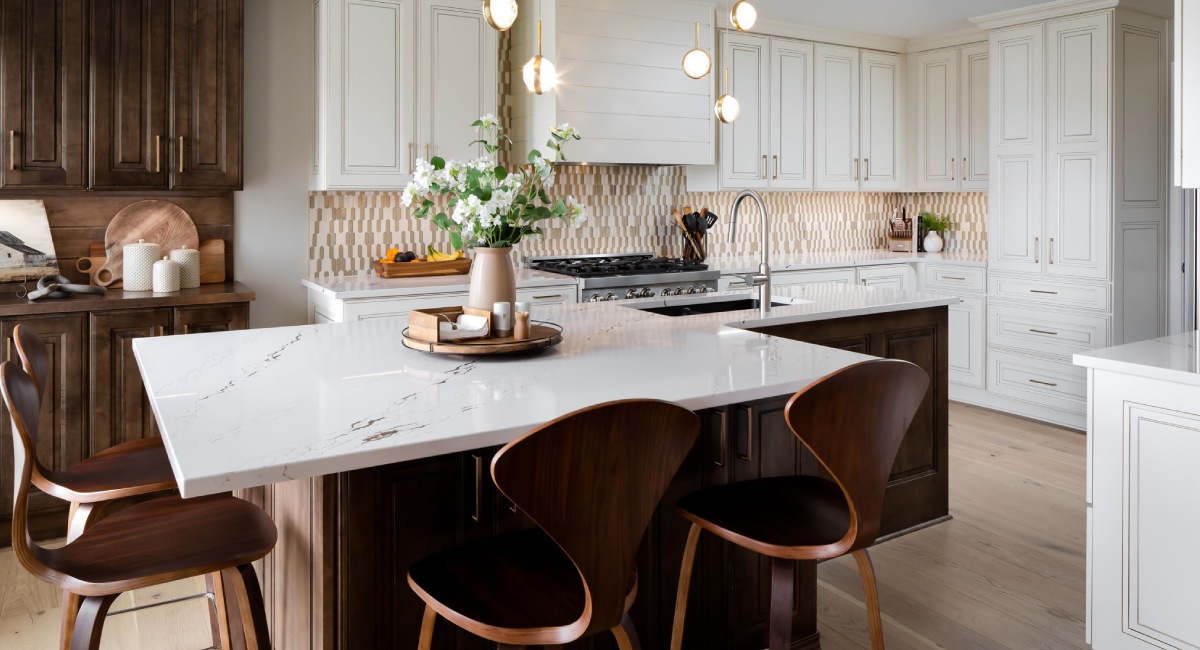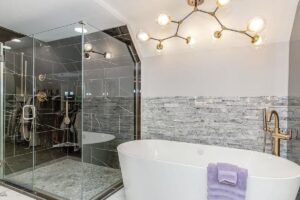Mixing metals in the kitchen is a clever way to bring character, contrast, and cohesion into your space. However, to ensure you achieve the proper aesthetic you are aiming for, it’s important to know how to do it right. Whether you’re planning a full kitchen renovation or just swapping out the cabinet hardware, remember that the mixed metal trend is here to stay.
More and more homeowners and their savvy interior designers are embracing the mixed metal kitchen trend, and for good reason. Done right, it adds depth, contrast, and a touch of curated elegance. If you’re tired of everything having to match perfectly and you are ready to level up your kitchen design, pull up a chair as the experts at Karin Ross Designs explain more below.
How to Mix Metals in a Kitchen
The key to mixing metals in kitchen design is balance. You wouldn’t wear five different patterns at once, and the same logic applies to finishes. Start by choosing a dominant metal that will make up about 60% to 70% of the finishes in the room. The metal can be matte black, brushed nickel, or even copper, depending on your style.
Once you’ve picked your dominant metal, bring in a secondary finish to add contrast. For example, pair warm tones like brass or gold with cool tones like chrome or stainless steel. The contrast can highlight architectural features, lighting fixtures, or your favorite cutting board from the artisanal shop. Mixing metals in interior design is all about layering with intention.
Mixed Metal Kitchen Decor
If you’re not ready to swap out your stainless steel appliances due to budget constraints, don’t worry. You can dip your toes into the trend with smaller pieces of mixed metal kitchen decor. Think cabinet pulls, faucet finishes, pendant lights, and even your barstool legs. Little accents can go a long way in creating a cohesive, designer look.
Incorporating a white kitchen with mixed metals is especially chic. White is a neutral tone that matches with everyone. Pairing gold hardware with a stainless steel range or matte black light fixtures against crisp white cabinetry creates contrast without clashing. Think of a Pinterest board come to life.
Mixed Metal Kitchen Ideas
The beauty of mixing metals in the kitchen is that it works across design styles. In a modern kitchen, try combining matte black with brushed brass. In a farmhouse setting, go for oil-rubbed bronze mixed with vintage pewter. If your look is industrial, blend stainless steel with raw, aged iron for that edgy, downtown loft aesthetic, which you can accomplish even if you live in the suburbs.
Kitchen islands are prime real estate for testing out mixed metal kitchen ideas. Maybe your island has polished chrome pendant lights overhead, but your barstools are matte black. It’s these thoughtful contrasts that will make your kitchen feel curated and collected.
Can You Mix Three Metal Finishes in the Kitchen?
If you are wondering if you can mix three metal finishes, the short answer is yes. The long answer? Yes, but be strategic. When mixing three metal finishes, think of it like designing jewelry for your kitchen. You’ve got your dominant metal, your secondary accent, and a third that pops in smaller doses.
If you want your main metal to be brushed nickel (classic), your secondary to be matte black (modern), and you want to add just a hint of copper (statement), there are some aspect ratios to keep in mind. Limit the copper to small accessories or open shelving brackets. The trick is to avoid visual overload. Three is the magic number. Adding any more than that can make your kitchen feel pugnacious instead of polished.
Can You Mix Ceramic Tiles and Metal Tiles in the Kitchen?
Mixing ceramic tiles and metal tiles in the kitchen is another bold way to bring visual interest into your space. If you want to elevate your backsplash, try using metal tiles as an accent among classic ceramic or subway tiles. A few brass inlays behind your stove or a strip of stainless steel in your otherwise neutral backsplash can go a long way.
Just remember to keep the tones consistent with your overall metal scheme. If your hardware is brushed gold, look for tiles in complementary warm hues. If your appliances are stainless steel, a few metallic silver mosaic pieces can subtly tie it all together. This type of detail exudes a designer look.
Where to Start When Mixing Metal Finishes in Kitchens
If you’re starting from scratch, such as during a full kitchen remodel, work with your kitchen remodelers in Kansas City to pick out your foundational finishes early. This gives you more room to play with accent metals later. Fixtures like faucets, cabinet hardware, and lighting are usually the easiest and most affordable pieces to swap out.
Don’t accidentally overlook your countertops. Quartz with subtle veining or a stone with warm undertones can help bridge the gap between cool and warm metals. It’s these small nuances that make mixing metals in the kitchen feel pro-level rather than trend-chasing.
Mixing Metals in Kitchen Design: Common Pitfalls to Avoid
Even though mixing metals in kitchen design is trendy, there are definitely a few things to avoid. Don’t mix two finishes that are too similar in tone. Brushed nickel and polished chrome may sound like opposites, but visually, they can look like a mismatch when side by side.
Also, watch out for placement. Don’t place all one type of finish in one corner and another elsewhere, as it will look disjointed. Disperse the finishes evenly throughout the space to maintain a sense of balance and cohesion. Your eye should glide from sink to stove to lighting without hitting a visual roadblock.
The Role of Lighting in a Mixed Metal Kitchen
Lighting can either unify your mixed metal kitchen or throw it into chaos. Choose fixtures that combine two metals, like a matte black sconce with brass detailing, to help bridge the different elements in your kitchen. These hybrid pieces may seem like polar opposites, but when placed next to each other, the look is enthralling.
Pendant lights over kitchen islands are a great place to make a statement. A two-tone fixture hanging over a butcher block island can bring together all the disparate finishes in the room into one harmonious spotlight.
Using Mixed Metals to Personalize a Modern Kitchen
Mixing metals doesn’t just create visual interest, but it tells a story. Want your kitchen to feel more curated and personal? Blending finishes make the space feel lived-in and thoughtfully layered. It also gives you flexibility over time. As trends shift or your tastes change, you won’t be locked into one outdated finish.
Modern kitchens benefit the most from this approach. A mixed metal kitchen breaks up the clean lines and sleek surfaces with a little texture and contrast. It’s the difference between a showroom and a home. In the hands of a skilled kitchen remodeling company in Kansas City, it’s a recipe for instant design credibility.










